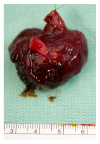Congenital Infantile Fibrosarcoma Causing Intestinal Perforation in a Newborn
- PMID: 28690909
- PMCID: PMC5485274
- DOI: 10.1155/2017/2969473
Congenital Infantile Fibrosarcoma Causing Intestinal Perforation in a Newborn
Abstract
Congenital infantile fibrosarcoma (CIF) is a rare malignant mesenchymal tumor and only 14 cases have been reported with gastrointestinal manifestation. We report about a female newborn delivered per emergency cesarean section at 34 weeks of gestation. Postnatally, she rapidly developed an acute abdomen and sonographic evidence of intestinal perforation requiring laparotomy on the first day of life. A perforated 2 × 3 cm sized spherical tumorous structure of the jejunum was identified. Due to unknown histopathology at this point and unclear resectional margins, she received a temporary ileostomy, which was closed two months later. Histopathology revealed a congenital intestinal fibrosarcoma without the characteristic ETV6-NTRK3 fusion transcript. In conclusion, this rare tumor must be considered as differential diagnosis of intestinal perforations in newborns.
Figures



References
Publication types
LinkOut - more resources
Full Text Sources
Other Literature Sources

